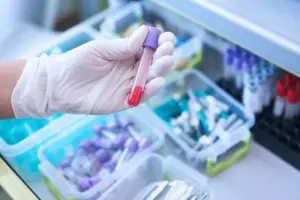Explore the reasons behind negative NIPT results, including false negatives and false positives, with expert insights supervised by doctors at Hiro Clinic. Understand the nuances for a clear understanding of your test outcomes.
NIPT is a nonconclusive test to determine the likelihood of disease
Prenatal diagnosis is a test to find out whether the baby in your womb has a birth defect caused by a specific chromosomal abnormality (chromosomal disease).
There are two types of prenatal diagnosis: non-confirmatory tests, which tell whether a chromosomal abnormality is possible, and confirmatory tests, which tell for certain whether a disease is present.
NIPT is one of the ‘non-confirmatory tests’. It uses a PCR (polymerase chain reaction) test to check for abnormalities in the baby’s DNA in the mother’s blood. The three chromosomal abnormalities that can be detected by NIPT are 13-trisomy (Patau syndrome), 18-trisomy (Edwards syndrome), 21-trisomy (Down syndrome).
Accuracy of NIPT and its implications
The terms ‘sensitivity’, ‘specificity’, ‘positive predictive value’ and ‘negative predictive value’ are often used to describe test accuracy.
The meanings of these terms are explained below.
What is sensitivity?
The probability that a person with a disease will test ‘positive’ is called ‘sensitivity’. Tests with high sensitivity are less likely to miss a disease.
A negative result is therefore more likely to rule out the absence of disease.
On the other hand, less sensitive tests can miss a negative result, so other tests should be used in conjunction.
is 99%, which is close to 100%, and the probability of missing a disease is extremely low.
The test is more accurate than other non-confirmatory tests (80% for combined tests and 83% for maternal serum marker tests).

What is specificity?
It is the probability that a person who does not have the disease will be ‘negative’ in the test.
A ‘positive’ result is material for diagnosing a person as having the disease, as false positives rarely occur in highly specific tests.
The specificity of NIPT is 99.90%, which is almost 100%.
This means that the probability of false negative results is very low, and if the test is ‘negative’, it is unlikely that a disease is present.
What is the target rate?
In all tests, including prenatal diagnosis, it is very important to know how correct the results are. The probability that the test result is correct is called the ‘positive predictive value’.
The probability that a person with a positive test result actually has the disease is called the ‘positive predictive value’, while the probability that a person with a negative test result actually does not have the disease is called the ‘negative predictive value’.
The ‘positive predictive value’ is most important for those undergoing NIPT.
A high ‘positive predictive value’ means that the probability that the test result is wrong and there is no real disease (false positive rate) is low, and a ‘positive’ test result means that there is a high probability of disease.
False positives and false negatives
A ‘negative’ test result in the presence of a disease is called a false negative, while a ‘positive’ test result in the absence of a disease is called a false positive.
The most common cause of false negative results is that the pregnancy is too early in the gestation week and there is not enough DNA in the baby to be detected.
False positives can be caused by a number of factors, including the fact that the pregnancy was actually twins and one baby was lost early due to a chromosomal abnormality (Vanishing Twin), or a hidden disease on the mother’s side, such as a tumour or autoimmune disease.
False positives and false negatives can also occur if the test is not carried out correctly, although this should not be the case.
Three NIPT test results: ‘negative’, ‘positive’ and ‘withholding judgment’
NIPT test results are divided into three categories: ‘negative’, ‘positive’ and ‘withholding judgment’.
To understand the test results correctly, it is necessary to know the correct meaning of each.
Being ‘negative’ for NIP
A ‘negative’ NIPT test result indicates that the probability of the baby having a chromosomal abnormality is extremely low.
For example, in the case of 21 trisomy (Down syndrome), it is understood that there is a 99.99% probability (negative predictive value) that you are not carrying a baby with 21 trisomy (Down syndrome).
The negative predictive rate of NIPT is known to be extremely high.
In a survey of pregnant women in the general population, the rate was also very high at 99.98%, and the probability of false negatives occurring was very low, less than 0.1%.
Being ‘positive’ for NIPT
A ‘positive’ NIPT test result indicates that the baby is likely to have a chromosomal abnormality.
It is therefore necessary to undergo a ‘definitive test’, either a trophoblastic test or an amniotic fluid test, to confirm the diagnosis.
However, as both trophoblastic and amniocentesis tests carry a small risk of miscarriage, it is important that couples discuss whether to have a definitive test or not.
Of the 72,526 cases performed in the NIPT consortium between September 2013 and March 2019, 1,281 (1.77%) tested ‘positive’.
The most common positive cases were 21 trisomy (Down syndrome) with 776 (1.07%), followed by 18-trisomy (Edwards syndrome) with 388 (0.54%) and 13-trisomy (Patau syndrome) with 117 (0.16%).
As the NIPT consortium targeted pregnant women at high risk of chromosomal abnormalities, the positive rate for pregnant women in the general population is considered to be even lower.
If a baby tests ‘positive’ for 21 trisomy (Down syndrome), the probability that the baby really has 21 trisomy (Down syndrome) (positive predictive value) depends on the mother’s age.
The higher the age, the higher the positive predictive value, as the probability of actually carrying a baby with the disease (disease frequency) increases.
For example, the positive predictive value for a 25-year-old is as low as 49.8%, while it jumps to 76.7% for a 35-year-old and 90.9% for a 40-year-old.
The positive predictive values for 13-trisomy (Patau syndrome) and 18-trisomy (Edwards syndrome) are also lower than for 21 trisomy (Down syndrome), as the disease frequency is lower.
The positive predictive values for pregnant women aged 40 and 40 years are reported to be 52.5% and 30.4% respectively.
What is withholding judgment?
is performed, less than 1% of the time, a ‘decision withheld’ result may be given.
This is due to a low level of baby-derived DNA in the mother’s blood, haemolysis, which is the breakdown of red blood cells in the mother’s blood, or a test error due to non-compliance with the measurement requirements of the testing equipment.
The baby-derived DNA is thought to increase over the course of the pregnancy, so blood can be drawn again and tested.

What is a positive score?
A useful tool in deciding whether to undergo a definitive test is the ‘positive score’, which is provided only at Hiro Clinic NIPT. The Positive Score is a value that indicates how far away the actual test result is from the cut-off value (reference value), which is the borderline between positive and negative results.
If the ‘cut-off value’ (reference value) and the actual test result are close, the likelihood of a false positive The higher the ‘positive score’, the further away from the ‘cut-off value’ (reference value) the actual test result value is.
The results of more than 66,000 NIPTs performed at Hiro Clinic NIPT to date show that pregnant women with a higher ‘positive score’ are more likely to have a ‘positive’ amniotic fluid test.
Also, a low ‘positive score’ does not mean that false positives are more likely.
Even if the actual test result value is relatively close to the ‘cut-off value’ (reference value), if the positive predictive value is high, there is a high probability that the amniotic fluid test will be ‘positive’. A positive score report is attached to those who have undergone NIPT at Hiro Clinic NIPT and have tested positive for 21 trisomy (Down syndrome) and 18 trisomy (Edwards syndrome).
The Positive Score Report shows the positive target rate calculated for each age, week and chromosome, along with the ‘positive score’.
Use this information to help you decide whether to actually have an amniotic fluid test by knowing where you stand with your test results.
【References】
- Ministry of Health, Labour and Welfare – NIPT: noninvasive prenatal testing
Q&A
-
QHow reliable is the accuracy of NIPT (new prenatal diagnosis)?NIPT is highly accurate, with a sensitivity of over 99%, and has a very high probability of detecting certain chromosomal abnormalities such as Down syndrome (21 trisomy), but it is a nonconfirmatory test and does not guarantee 100% accuracy.
-
QWhat is the “positive score” provided by NIPT, a prenatal diagnosis?A positive NIPT score is an indicator of the confidence level of a positive result; the higher the score, the more likely it is that a chromosomal abnormality is actually present.
-
QWhat are the circumstances in which a “decision is withheld” by NIPT (new prenatal diagnosis)?Withholding judgment means that the test result is unclear and will need to be retested. This can occur for reasons such as a hemolysis with low baby-derived DNA.
-
QWhat is the false positive rate for NIPT (new prenatal diagnosis)?The false positive rate for NIPT is very low, but not zero. If you receive a false positive result, it is recommended that you undergo additional testing, such as amniotic fluid testing for a definitive diagnosis.
-
QIs it possible to have a chromosomal abnormality even though the NIPT (Negative In Vitro Prenatal Diagnosis) was “negative”?False negative results are very rare, but possible, and although NIPT has a high sensitivity of over 99%, 100% accuracy cannot be guaranteed.
-
QWhat are the causes of a false negative NIPT result?The main causes are too early in the gestation week to detect sufficient fetal DNA, or technical errors. These factors may cause inaccurate results.
-
QWhat is the probability of a false negative result with NIPT?The probability of false negative results is very low, generally less than 0.1%. However, the accuracy of the test may vary depending on the institution and the number of weeks of pregnancy.
-
QIf the NIPT result is negative, do I still need to take an additional test?Generally, a negative result does not require additional testing, but if there is a family history or other risk factors, it is recommended that additional testing be considered in consultation with a physician.
-
QHow can I be sure that a negative NIPT result is accurate?The accuracy of a negative result can be confirmed by undergoing a definitive amniotic fluid or chorionic villus test.
-
QWhat can I do to prevent false negatives?It is important to undergo NIPT at the appropriate number of weeks of pregnancy (10 weeks or later). It is also recommended to have the test performed at a reliable medical institution.
-
QWhat should I do if the NIPT is negative but the baby actually has chromosomal abnormalities?If a postnatal diagnosis reveals chromosomal abnormalities, it is important to follow up with a specialist and develop a treatment plan.
-
QWhy am I still concerned even if NIPT shows a negative result?Because NIPT is a nonconclusive test and the possibility of a false negative result cannot be completely ruled out, anxiety may remain.
-
QIs it safe to trust a negative NIPT result?The negative predictive rate of NIPT is 99.98%, which is very high, so generally speaking, you can rest assured. However, if you have any concerns, we recommend that you consult your physician.
-
QAre there any characteristics of pregnant women who are prone to false negative results with NIPT?Cases in which false negatives are more likely to occur include pregnancies of less than 10 weeks and cases in which the mother has certain health conditions.
-
QAre there any cases of chromosome abnormalities being found after birth even if NIPT is negative?Yes, it is very rare, but such cases have been reported. In the case of a false negative, it is possible that the test missed the problem.
-
QHow can I properly understand a negative result?It is important to listen carefully to the doctor's explanation and seek genetic counseling if necessary. Also, do not interpret test results easily and seek professional opinion.
-
QWho is responsible for false negative results with NIPT?False negative results can occur due to the nature of the test. Therefore, the medical institution or test provider is responsible for explaining the limitations of the results.
-
QWhat type of medical institution should I choose to reduce the risk of false negatives?It is important to choose a reliable medical institution with sufficient experience and a proven track record. It is also advisable to choose a facility that offers advance genetic counseling.
-
QWhat should I do to avoid overconfidence in a negative NIPT result?It is important to understand that NIPT is a nonconclusive test and that a negative result does not guarantee 100% safety.
-
QIs there anything I can do to reduce my anxiety about a negative NIPT result?Genetic counseling before and after the test to fully understand the limitations of the test and interpretation of the results can help reduce anxiety.
Explore the reasons behind negative NIPT results, including false negatives and false positives, with expert insights supervised by doctors at Hiro Clinic. Understand the nuances for a clear understanding of your test outcomes.
Article Editorial Supervisor

岡 博史先生
【役職】
【資格】
【略歴】
【所属】
【SNS】
 中文
中文













